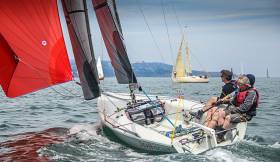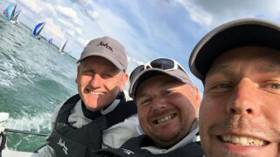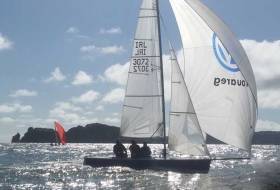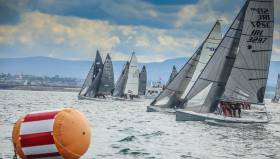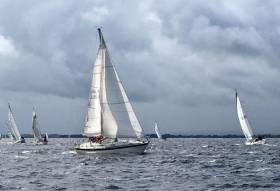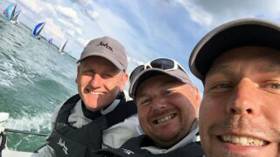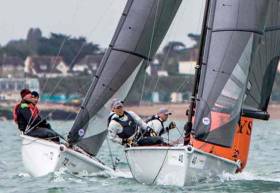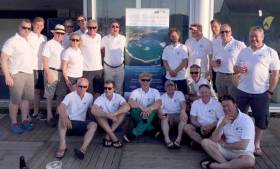Displaying items by tag: SB20
Irish National Sailing Club's 'Super Series' Adds SB20s to Dun Laoghaire Winter Series
The Irish National Sailing Club Super Series is expanding this year and as well as racing for RS200/400s, the Dun Laoghaire Harbour based winter series will also include racing for SB20 sportsboats.
With a 10am first gun, the aim is to do as many sprint style racing races as possible (max 5) and off the water by 1pm.
The schedule will be five race Saturdays over the winter from November 11th. And then on December 16th, January 13th, February 10th and March 10th.
There will be simple windward–leeward courses with a leeward gate and spreader at top with a start/finish line at the bottom of the beat.
The cost is €50 to enter the series per boat either SB20 or RS200/400.
Check out the 2016/17 RS Super Series video below for a flavour of the action...
Enter here
SB20 2018 Irish Fixtures List Includes European Championships
2018 will be a stand out year for the Irish SB20 class with the and European Championships taking place in Dublin Bay at the end of August.
Club racing will continue next summer in both Dublin Bay and on Lough Derg. There are now six SB20s based on Lough Derg.
Irish Sailing will hold the Champion of Champions Regatta in SB20s in 2018 at Lough Ree YC the weekend after the SB20 Midland Championships.
The list of events for 2018 is as follows:
28th - 29th April - Western Championships - HYC
26th - 27th May - Northern Championships - Whiterock - SLYC
29th June - 1st July - National Championships - Dun Laoghaire - NYC
14th - 15th July - Southern Championships - Cork - RCYC
11th - 12th August - Eastern Championships - Dun Laoghaire - RStGYC
28th August - 1st September - European Championships - Dun Laoghaire - RIYC
6th - 7th October - Midland Championships - Athlone - Lough Ree YC
Michael O’Connor & Sin Bin SB20 Crew are September’s 'Sailor of the Month (Inshore)'
Michael O’Connor of Royal St George YC is the Afloat.ie “Sailor of the Month (Inshore)” after celebrating September with the Corinthian Division overall win in the SB20 Worlds on the Solent early in the month and then, in an intense three day series of multiple sailing conditions at Howth from Friday 15th to Sunday 17th September, he and his shipmates Davy Taylor and Edward Cook took the Irish title.
It speaks volumes for the quality of racing at the front of the contemporary Irish SB 20 fleet, that the winner of a major title at the worlds should have had to sail as hard and consistently as the crew of Sin Bin did at Howth. But they took the Irish title despite the best efforts of former Irish Champion Helm Stefan Hyde to deny them the prize. It all augurs well for a quality event when the SB 20 Euros come to the Royal Irish YC in Dun Laoghaire next year. But just for now, here’s to the Sin Bin, and all.
World Champion O’Connor Takes 2017 Irish SB20 Title Through Thick & Thin & Gin
New SB20 World Corinthian Champion Michel O’Connor of Royal St George YC took the class’s Irish title yesterday afternoon after a hectic series at Howth Yacht Club in which the 21–strong fleet experienced an entire year’s worth of weather in just three days writes W M Nixon.
Afloat, they came through thick and thin, and then ashore they cheerfully waded through gin as well. The Irish Nationals coincided with the first weekend of the HYC Autumn League at the peninsula port, and on the Friday night HYC Commodore Joe McPeake took the opportunity to introduce his members and friends to the new HYC–branded gin (we are not making this up), and the amiable SB20 crowd took that in their stride as well.
In fact, the SB 20s proved very popular guests. Long gone from their scene are the here-today gone-tomorrow types who sometimes soured the class in times past in Cowes Week, where the SB 20 people will tell you such problem children have now all moved on to the new J/70s. That’s maybe a bit unfair to the J/70s, but there you go.
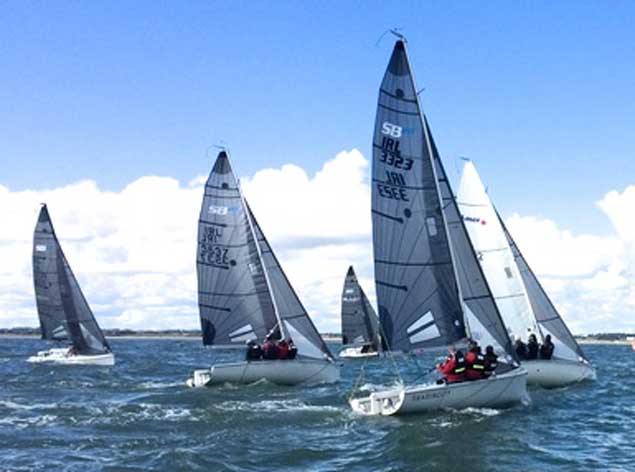 Marty Cuppage’s Sea Biscuit (Howth YC, foreground) trying to keep things in hand on Broomsticks (M O’Leary, Greystones SC), but Altair under the lee bow is giving her a bad time. And at the finish, the Greystones boat was twelfth overall while the Howth boat was thirteenth. Photo: Serena Blacoe
Marty Cuppage’s Sea Biscuit (Howth YC, foreground) trying to keep things in hand on Broomsticks (M O’Leary, Greystones SC), but Altair under the lee bow is giving her a bad time. And at the finish, the Greystones boat was twelfth overall while the Howth boat was thirteenth. Photo: Serena Blacoe
Meanwhile in Ireland the SB 20 class these days is made up of solid sporting enthusiasts with a great sense of camaraderie. And with the O’Connor win at Cowes in the Worlds at the beginning of September, the fleet at home had a gold standard benchmark to measure their performance at the Howth event, but the weather was determined to test them as well.
Friday’s races saw them pushing towards the limit, with 24 knots frequently on the wind clocks, while Saturday saw a more moderate northerly, but a well-forecast band of heavy rain moved remorselessly across the race area in mid-afternoon. Then on Sunday the weather Gods decided to relent, and they rounded out in sunshine, but with a rising barometer the distinctly crisp wind direction could be fickle.
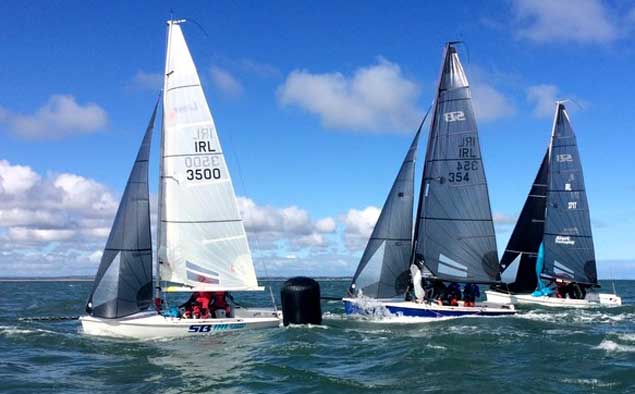 Peter Kennedy’s Ridgefence.com from Strangford (third overall at finish) ahead of Cillian Dickson (HYC) with Binn Eadair Racing (7th OA). Photo Serena Blacoe
Peter Kennedy’s Ridgefence.com from Strangford (third overall at finish) ahead of Cillian Dickson (HYC) with Binn Eadair Racing (7th OA). Photo Serena Blacoe
Far from walking away with the series, O’Connor looked to be playing second fiddle to Stefan Hyde (formerly Cork, these days sailing under RIYC colours) in the early stages, as Hyde logged first, third and first to O’Connor’s three seconds on the Friday. Peter Kennedy of Strangford was next in line with an 8th, 1st and 5th, while Daragh Sheridan was best of the home fleet in the end, but his first day saw two thirteenths and a fourth.
However, in Saturday’s increasingly murky conditions, O’Connor came good with 2nd, 5th and 1st to Hyde’s 7th, 3rd and 7th, so it was Game On for Sunday’s sunny racing. There was a bit of covering going on, as O’Connor was prepared to take an 8th while Hyde was back in 9th, but by this time O’Connor could make do with a 3rd and 5th in the final races and still stay 3 points clear ahead on the leaderboard.
Overall, it was by no means a walkover. The honours were well spread, and the class were in a fine form in an excellent series enjoyed by participants and hosts alike. But before we run the top points place, could the Afloat.ie Thought Police just make the point that the plural of gin and tonic is gins and tonic………
International SB20 Class Irish National Championship 2017 1st Michael O’Connor (RStGYC) 22pts; 2nd Stefan Hyde (Royal Irish YC) 25pts; 3rd Peter Kennedy (Strangford SC & Royal North of Ireland YC) 30pts; 4th Daragh Sheridan (Howth YC) 45 pts; 5th D Martin (Strangford Lough YC) 53 pts; 6th C. Galavan (RIYC) 66pts.
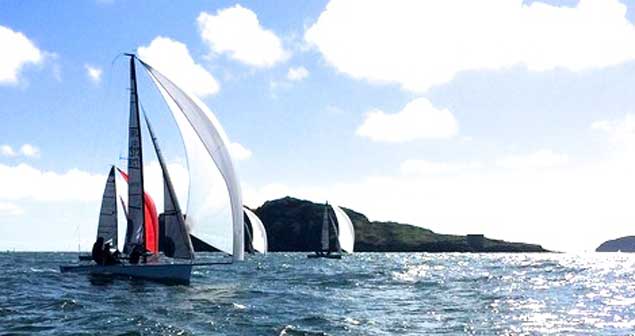 After a decidedly mixed summer, even one day of that magic Autumn sunlight goes a long way. The Irish SB 20 fleet having themselves a fine old time at Howth on Sunday. Photo: Serena Blacoe
After a decidedly mixed summer, even one day of that magic Autumn sunlight goes a long way. The Irish SB 20 fleet having themselves a fine old time at Howth on Sunday. Photo: Serena Blacoe
Royal St. George Yacht Club World Champions Eye SB20 Irish Title At Howth
Recently crowned Corinthian SB20 World Champions Michael O'Connor, Davey Taylor and Edward Cook are eyeing the Irish National title in Howth Yacht Club next weekend as the class surges ahead of the European Championships at the Royal Irish Yacht Club next August.
On foot of the 2018 Irish-based Euros and this month's Irish team's success in Cowes, Class President, Colin Galavan, has said that there has been 'a flurry of activity' regarding SB20 boat sales with some talented sailors looking at joining the Irish class.
Current National Champions Bad/Kilcullen (Stefan Hyde, Gerry & James Dowling) who, according to Galavan, may feel they 'underachieved at the Worlds' will see Howth as an opportunity to redress the balance in three days of windward leeward courses.
Some Dun Laoghaire boats are planning to sail in-company across the bay on either Wednesday or Thursday evening for HYC Championships.
LaBamba Claims Gortmore Bell Race on Lough Derg
The Gortmore Bell Race, sponsored by Union Chandlery took place this Saturday on Lough Derg with 23 boats taking part across two classes.
This is the lough's longest race in the calendar from Iniscealtra Sailing Club’s base in Mountshannon to the Gortmore mark near Portumna and home via Mountaineer rock buoy near Domineer.
Class 2 got underway first at 10:45 followed 30 min later by class 1 at 11:15 in a NW breeze which was set to increase as the morning went on. 1st around the Gortmore mark and heading for home was Serendipity helmed by Robert Bourke, first around in Class 1 was Jumping Jack Flash helmed by Dominic O’Sullivan. The breeze increased to 30–kts at times which made for exiting reaching conditions for the three SB20’s in the fleet who managed to hold they asymmetric spinny’s from Coose mark to Mountaneer bouy. Line honours was claimed by the SB20 Jumping Jack Flash followed quickly by the rest of the fleet with all boats finished by 16:40pm.
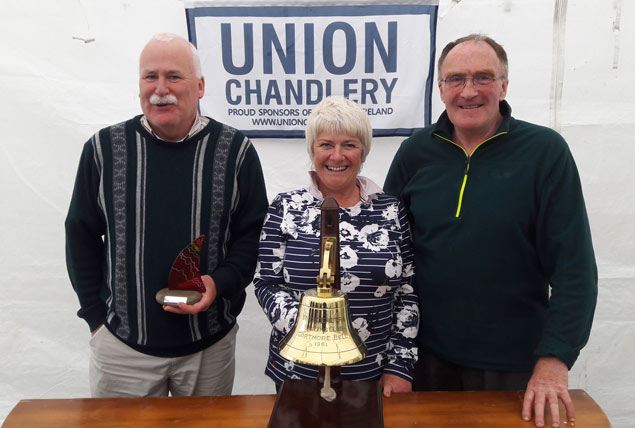 Gortmore Bell Winners 2017 – (from left to right) Sean Collins, Mary and Mike Sadlier of La Bamba
Gortmore Bell Winners 2017 – (from left to right) Sean Collins, Mary and Mike Sadlier of La Bamba
1st Place Overall and in Class 1 was LaBamba helmed by Mary Sadlier and crewed by Mike Sadlier and Sean Collins, 1st Place in Class 2 was Serendipity helmed by Robert Bourke, 1st Place in J24 fleet was Jobs for the Buoys, helmed by Barney Power and 1st place in SB20 fleet was claimed by Jonathan Foley’s Jumping Jack Flash helmed by Dominic O’Sullivan.
Full results attached below for download.
Corinthian SB20 World Title for Royal St. George Trio in Cowes
Royal St. George's Michael O'Connor, Davy Taylor and Ed Cook are the SB20 'Corinthian' World Champions following today's final races in Cowes.
The Dun Laoghaire boat, that is a regular top DBSC performer, fell back two places overnight to finish sixth overall in the World Championships beating many of the top professionals.
There were also congratulations also to the rest of the Irish team that traveled to the event and finished well which bodes well for the 2018 SB20 Europeans to be held on Dublin Bay.
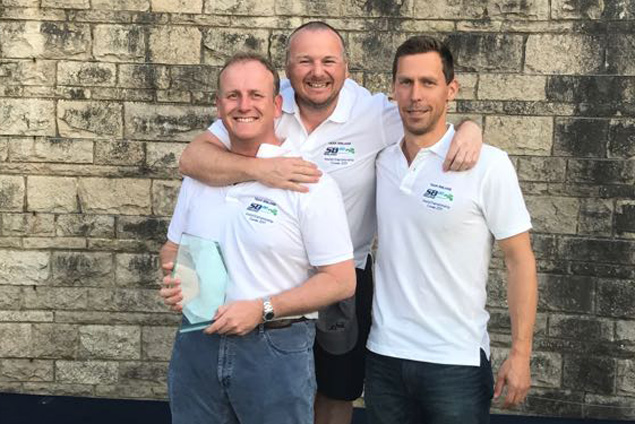 SB20 Corinthian World Champions Michael O'Connor, Davy Taylor and Ed Cook
SB20 Corinthian World Champions Michael O'Connor, Davy Taylor and Ed Cook
Team Ireland finished strong with the following final places as follows:
6th SINBIN Michael O'Connor, Davy Taylor, Ed Cook
17th Bad/Kilcullen Stefan Hyde, Jerry Dowling, James Dowling
29th Lia Dave Barry, Cillian Dickson, Gareth Nolan
34th Venuesworld Ger Dempsey, Graeme Grant, Chris Nolan, Diane Kissane
35th Two Men and their Monkey Daragh Sherridan, Shane Murphy, John Phelan
65th Sea Biscuit Marty Cuppage, Niall O'Riordan, Barry Galvin
Royal St. George Yacht Club Trio Now Lying Fourth At SB20 Worlds
Royal St. George Yacht Club's Michael O'Connor, Davy Taylor and Ed Cook are looking for a podium finish at the SB20 World Championships in Cowes today.
The Dun Laoghaire trio are fourth overall and ten points off the lead and four points off the podium after a stunning penultimate day of racing.
O'Connor is in first position for the Corinthian Trophy and beating many of the professional sailors to boot!
The forecast is for light winds again today but who knows what the wind gods will throw at the fleet today.
After four days of racing a new world champion will be crowned this evening at the Royal Yacht Squadron and Ireland is in with a shout.
Competitors got four races yesterday in what turned out to be a windier day than predicted. It was pretty shifty with the breeze varying between 6-25 knots in conjunction with strong tides, making this yet another tricky day of sailing.
With conditions making it hard to be consistent, O'Connor's Dublin Bay–based Sin Bin scored a 2, 3, 6 and 17 to move up from seventh to fourth overall.
it was a tough day for tacticians with no rest from the changeable weather. With a full day of racing now behind us a lot of the top teams are carrying big scores ahead of the final day tomorrow.Now we’ve got one more day to go tomorrow with the potential for an additional three races.
A lot of boats will hope they used their discard up today as there is only one in this final series.
Competitors will compete in the final few races before the new World Champion is crowned tonight.
The results currently stand as follows:
1. Export Roo – Australia
2. Give Me Five! – France
3. Xcellent – Great Britain
4. Sin Bin – Ireland
5. Sportsboatworld.com – Great Britain
6. Marvel – Great Britain
For a full list of results click here
Team Ireland are making a great showing as follows:
4th SINBIN Michael O'Connor, Davy Taylor, Ed Cook
22nd Bad/Kilcullen Stefan Hyde, Jerry Dowling, James Dowling
27th Lia Dave Barry, Cillian Dickson, Gareth Nolan
31st Venuesworld Ger Dempsey, Graeme Grant, Chris Nolan, Diane Kissane
36th Two Men and their Monkey Daragh Sherridan, Shane Murphy, John Phelan
61st Sea Biscuit Marty Cuppage, Niall O'Riordan, Barry Galvin
After five races sailed at the SB20 World Championships in Cowes, Royal St. George's Michael O'Connor, Davy Taylor and Ed Cook is up to seventh overall – just 14 points off the leader – in the highly competitive 79–boat fleet.
Wind finally arrived for two races on the Solent yesterday with Dun Laoghaire's O'Connor as high as fourth overall after race four.
Australian Expert Roo notched up another win in race five of the championships and takes a five-point lead into the final series.
Six Irish crews are competing in Cowes ahead of the SB20 Euros to be held at the Royal Irish Yacht Club in Dun Laoghaire in August 2018.
Overall positions for team Ireland are as follows: 7th Sinbin Michael O'Connor, Davey Taylor, Edward Cook; 20th Bad/Kilcullen - Stefan Hyde, Gerry Dowling, James Dowling; 27th Lia; 30th Venuesworld; 38th Two Men & Their Monkey and 62nd Seabiscuit. Overall results are here
O'Connor's Sinbin in Top Ten of SB20 Worlds, Team Ireland Present 2018 RIYC Hosted Euros
Michael O'Connor's Sinbin of the Royal St. George Yacht Club scored a third in race two to rise up the leader board of the SB20 World Championships at Cowes, Isle of Wight yesterday. O'Connor, as the top Irish entry, now lies in ninth position overall after another day of light winds saw only one race completed.
Overall positions for team Ireland are as follows: 9th Sinbin Michael O'Connor, Davey Taylor, Edward Cook; 19th Bad/Kilcullen - Stefan Hyde, Gerry Dowling, James Dowling; 31st Venuesworld; 38th Lia; 49th Seabiscuit and 51st Two Men & Their Monkey. Overall results are here
Clearly, the challenging conditions were a stern test for the crews who returned to shore looking closely at the forecast.
A good breeze is forecast for today but the light condition are expected to return towards the end of the week.
Meanwhile, Team Ireland has made a presentation in Cowes about its staging of the Royal Irish Yacht Club hosted SB20 European Championships that will be sailed in Dun Laoghaire in August 2018.




























